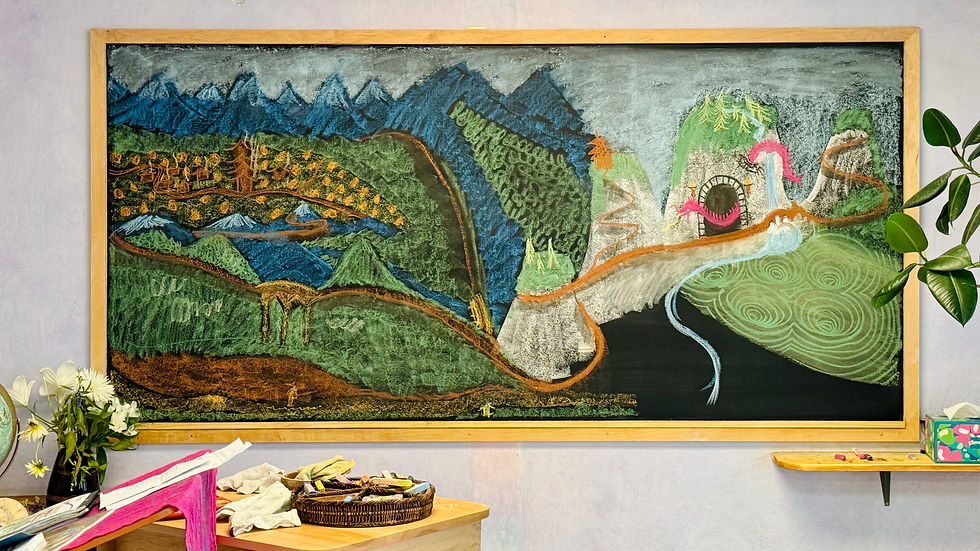How Waldorf Schools Encourage a Love for Reading Through Storytelling
- Nevada Sage Waldorf School

- Aug 26
- 3 min read
If you're a parent searching for elementary schools in Reno, NV and looking for something more than worksheets and screens, you may be wondering how an alternative education like Waldorf nurtures key academic skills such as reading.
At Nevada Sage Waldorf School, we believe that a lifelong love for reading begins with something simple (and as powerful) as storytelling.

Why Storytelling First?
In Waldorf education, we don't rush into reading instruction. Instead, we begin with what every child already knows and loves: the spoken word. Story telling (rich, imaginative, and human) is at the heart of early childhood and the foundation of literacy in a Waldorf

classroom.
Rather than breaking reading abstract rules too soon (like phonics drills or sight word memorization), Waldorf teachers build a deep, organic connection to language. By listening to fairy tales, folk tales, myths, and fables (all told from memory) children develop:
Strong listening skills
Rich vocabulary
Sequencing and comprehension abilities
Imagination and visualization
A love for language and story
These are the cornerstones of reading readiness, and they develop in a natural, joyful way without pressure.
Reading in Harmony with Child Development Leads to a Love of Reading
Many public school programs begin formal reading instruction in kindergarten or even preschool. But at Waldorf schools, we respect each child's individual developmental readiness. We wait until around 1st Grade, when most children are naturally ready, to begin formal instruction in reading and writing.

This approach aligns with research from child development experts like Jean Piaget, who emphasized the importance of developmental stages in cognitive learning. In Waldorf education, children are introduced to letters and sounds through art, story, and movement, rather than rote memorization. For example:
Children learn the letter "M" through a story about mountains and then draw mountains shaped like the letter "M."
They act our the shapes of letters through movement games and drawing.
Reading emerges naturally through writing and storytelling, as children create their own books filled with illustrated stories and poems.
The result? Children not only learn to read, they learn to love reading. They associate reading with creativity, imagination, and joy.
Building a Relationship with Language
Waldorf classrooms don't use basal readers or leveled reading groups in the early grades. Instead, children are immersed in high-quality literature that speaks to their developmental stage:
Kindergarten and early grades: Folk and fairy tales
2nd & 3rd Grade: Fables and stories from around the world
Upper elementary: Norse myths, legends, and historical biographies
Because these stories are told aloud and retold often, children internalize beautiful sentence structures, expressive vocabulary, and a strong sense of narrative. These internal patterns become the blueprint for both their reading and writing.
A Gentle Path to Literacy Success
You may wonder: if formal reading starts later in Waldorf, do children fall behind?
Not at all.
According to studies like the Cambridge Primary Review and research on Waldorf students in Europe and North America, children who begin reading later often catch up to, and even surpass, their peers in traditional schools by 3rd or 4th grade. More importantly, they tend to enjoy reading more and read for pleasure throughout their lives.
Why This Matters in Today's World
In a culture that often values speed over depth, Waldorf schools choose a different path; one that gives children the time and space to develop a meaningful relationship with language.
For families looking for private elementary schools in Reno, NV, Nevada Sage Waldorf School offers a nurturing alternative that respects the child's natural growth and honors the powers of story.
We believe that learning to read shouldn't be a race. It should be a journey of wonder.

Want to see storytelling in action?
Schedule a tour where you'll see how imagination, rhythm, and story gently lay the foundation for confident, joyful readers.




Comments